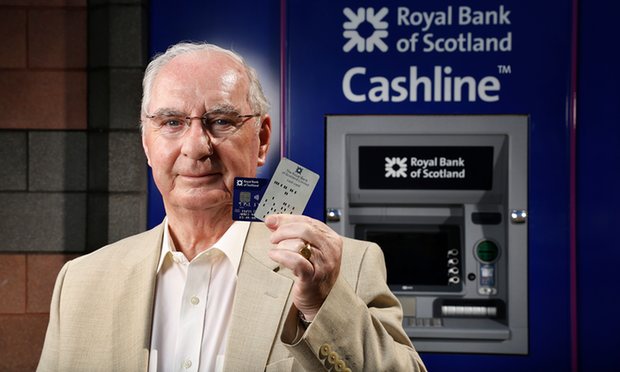ATM inventor earned $ 15 on his idea for 50 years

The patent system allows the inventors of many things now popular to earn millions of dollars. I remember that in some American comedy a moment was played up, where one of the film’s heroines is a very wealthy person, because her grandmother invented a spring for a toaster, and the whole family still receives deductions from toaster producers. In general, this is close to the truth, despite the fact that the film is comedic.
But there are exceptions. James Goodfellow, who patented the device for automatically issuing paper money to bank customers, earned almost nothing. He received $ 15, and that's all. But the ATMs are used by billions of people, the devices themselves - millions (3 million, more precisely).
The Guardian recently published an interview with Goodfellow, in which the inventor shared the history of the creation of an ATM. Rather, its prototype, there are still some differences between the original invention and modern ATM. The inventor claims that the very concept of the machine for issuing money came to mind not only to him, but here's the idea that led to the creation of the ATM - it was him. Here he recalls the Wright brothers, who did not create the very concept of flight, along with them (and before them) many people were engaged in this. But they created a working prototype of the aircraft that could fly, and therefore they are considered the creators of the aircraft.
')
Goodfellow says that few people know about his patent, and he himself didn’t tell anyone anything until 2005, when a completely different person, John Shepherd-Barron, received an award for inventing an ATM. The award is the Order of the British Empire. Interestingly, Goodfellow received a similar order, not for inventing an ATM, but for introducing PIN codes for these devices. Shepherd-Barron, by the way, does not have a patent for a cash dispenser for bank customers, although he created a similar device at about the same time as Goodfellow.
The cash withdrawal system for bank customers at any time was created by Goodfellow in the mid-60s. Then he worked in a large company Kelvin Hughes. The task to develop a system for issuing money after the end of the working day was received from the authorities. As a result, the inventor came up with a system that could issue funds to a bank customer after his customer identification. The identification process was two-factor - the client had to insert a special plastic card with perforated holes into the slot (their placement was unique for each client), plus enter their PIN code (10-digit).
The system for issuing money was created, and the first such machine was installed in 1967 in one of the branches of Westminster Bank.
A similar system of authorship of another inventor, Shepherd-Burrow, was also established in 1967, and a month earlier than the Goodfellow system. However, the patent for the invention belongs to the hero of this publication. He filed patent applications in the bureau of 15 countries. The analogue also gave out money after customer identification, but here it was not a plastic card that was used, but a check with a carbon isotope, carbon-14.
Authorship Goodfellow recognized already in the government. And in the book Life in the United Kingdom (it should be studied by those who would like to receive British citizenship) Goodfellow is already listed as the creator of the ATM.
According to him, the invention did not change his life. But Goodfellow is pleased with everything. “I really liked to do my job,” says the inventor of the ATM.

Source: https://habr.com/ru/post/368893/
All Articles